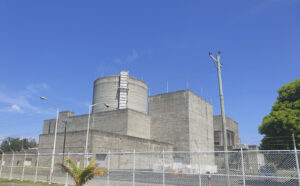Publications

SYNOPSIS
The Philippines is seeking nuclear energy partnerships with various countries and allies as it aims to address the twin challenges of achieving energy security and reducing carbon emissions. How can advanced small modular nuclear reactors help the Philippines in its transition to clean energy?

COMMENTARY
Philippine President Ferdinand Marcos Jr has discussed climate change and clean energy transition while pushing for nuclear power and renewables in recently concluded regional summits and key bilateral talks with allies and partners. This is part of the Philippines’ intensified search for suppliers of nuclear-powered reactors, including advanced small modular reactors (SMRs), to address the twin challenges of achieving energy security and reducing carbon emissions.
The Philippines is not alone in this; at the recently concluded COP27 in Egypt, the International Atomic Energy Agency (IAEA) said that the climate crisis and the energy crisis have prompted more countries, including the Philippines, to look to nuclear power as part of the solution.
Growing Optimism for Nuclear Power and SMRs
The Philippines’ growing interest in nuclear power for its clean energy transition is a reflection of the “rising global optimism on nuclear power,” which is, as the IAEA panel at COP27 depicted, “making a strong comeback.” Driving this momentum is the insatiable demand for low carbon energy, as well as secure and reliable energy.
Proponents of nuclear power promote SMRs as a right fit for developing countries heavily dependent on cheap but dirty fossil fuels. More than half of the Philippines’ electricity generation capacity comes from imported coal. But with the Philippines government’s moratorium on building new coal-fired power plants, SMRs may potentially broaden the clean energy options for the country. Furthermore, SMRs are perceived by their proponents to be ideal for isolated Philippine regions that are not connected to the main grid.
As of now, SMR technology is well-developed in countries such as the United States, South Korea, Russia, and China and may be deployed commercially soon in the coming years. Advanced reactors may play a pivotal role in meeting the climate goals of countries, which are interested in using nuclear energy for the first time. They can even facilitate hybrid synergies between nuclear technology and renewables.
Senior Filipino energy and nuclear regulatory officials have in fact been promoting both renewables and nuclear energy as complementary low-carbon sources. While advanced reactor technology has been progressing rapidly, there are many challenges to the introduction of SMRs and floating nuclear power plants, which are another clean alternative.
Seeking Nuclear Energy Partnerships
At the meeting between US Vice President Kamala Harris and President Marcos Jr in Manila on 21 November, they announced the commencement of their bilateral negotiations on a civil nuclear energy cooperation agreement (“123 agreement”) to boost their cooperation on clean energy and non-proliferation priorities with the use of SMR technology.
Marcos is also interested in exploring a nuclear energy partnership with France which he conveyed to French President Emmanuel Macron during a meeting on 18 November on the side-lines of the Asia-Pacific Economic Cooperation (APEC) Summit in Bangkok, Thailand.
South Korean President Yoon Suk-yeol also held a summit with Marcos on 12 November on the side-lines of the ASEAN Summit held in Phnom Penh, Cambodia during which they discussed the ways in which South Korea can assist the Philippines in the use of nuclear power.
These and other meetings held under the recently inaugurated Marcos’ administration may advance the Philippines’ revitalised nuclear power journey. With the goal of building nuclear power plants within the six-year term (2022-2028) of Marcos’ administration, the government is now energetically looking for potential suppliers of SMRs as these are faster to construct than conventional nuclear power stations. This may complement the possible rehabilitation of the mothballed Bataan Nuclear Power Plant, which was built and completed in 1985 during the regime of Ferdinand Marcos, the late father of the current president.
According to senior Filipino officials, the Marcos administration is keen on importing SMRs from the US. The president himself had already met executives of NuScale Power, an American company that designs and markets SMRs.
According to the US Department of Energy, the key features of advanced SMRs being developed by the US include comparatively small physical footprints, reduced upfront cost, feasibility to be sited in locations not possible for larger nuclear plants, and provisions for incremental power additions. The proposed “123 agreement” on nuclear cooperation between the US and the Philippines will pave the way for the US to export nuclear equipment and material, including SMRs, to the Philippines.
Establishing Governance for SMRs: the Challenges
Amending the complex regulatory and legislative frameworks on nuclear power and energy security is a significant challenge, however, to the Philippines’ nuclear power journey, and most especially to the deployment of SMRs upon approval. In the absence of any acceptable model of commercial SMRs, licensing and regulatory standards for this technology would remain abstract. This presents a significant amount of work that needs to be done by the Philippine nuclear regulatory framework as it needs to be updated and adapted to include this new reactor technology. Currently, the Philippine Congress is deliberating on amending legislative and regulatory frameworks on nuclear safety, security, and safeguards.
There has been an ongoing global effort to harmonise regulatory and licensing requirements for SMRs through the SMR Regulators’ Forum hosted by the IAEA. The Philippines, along with other Asia-Pacific countries, must be able to participate fully and contribute to the reshaping of global nuclear governance as future users of this new reactor technology.
There is a need to revisit existing international nuclear conventions and regimes to assess whether SMRs are adequately covered. It has yet to be determined whether existing conventions can still be applied to SMRs even without amendments or new conventions.
Specific international guidelines on SMR’s safety, security and safeguards would be needed to consider their unique specifications. For the Philippines, it must also address critical preparatory issues and gaps in its own domestic nuclear governance to ensure the safe, secure, and peaceful use of SMRs and the nuclear power generated.
About the Author
Julius Cesar Trajano is Research Fellow with the Centre for Non-Traditional Security Studies, S Rajaratnam School of International Studies (RSIS), Nanyang Technological University (NTU), Singapore.
